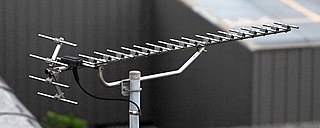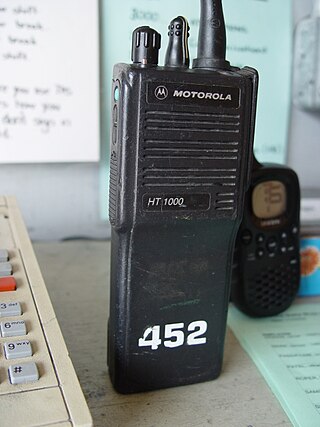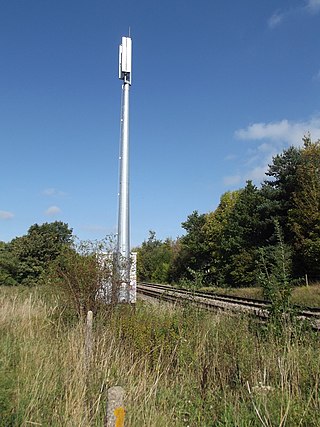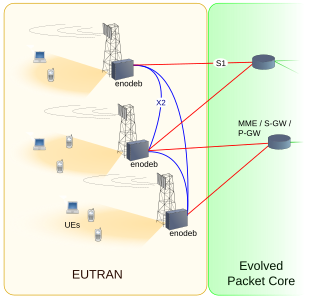
The Global System for Mobile Communications (GSM) is a standard developed by the European Telecommunications Standards Institute (ETSI) to describe the protocols for second-generation (2G) digital cellular networks used by mobile devices such as mobile phones and tablets. GSM is also a trade mark owned by the GSM Association. "GSM" may also refer to the voice codec initially used in GSM.

General Packet Radio Service (GPRS), also called 2.5G, is a mobile data standard on the 2G cellular communication network's global system for mobile communications (GSM). Networks and mobile devices with GPRS started to roll out around the year 2001. At the time of introduction it offered for the first time seamless mobile data transmission using packet data for an "always-on" connection, providing improved Internet access for web, email, WAP services, and Multimedia Messaging Service (MMS).
The Universal Mobile Telecommunications System (UMTS) is a 3G mobile cellular system for networks based on the GSM standard. Developed and maintained by the 3GPP, UMTS is a component of the International Telecommunication Union IMT-2000 standard set and compares with the CDMA2000 standard set for networks based on the competing cdmaOne technology. UMTS uses wideband code-division multiple access (W-CDMA) radio access technology to offer greater spectral efficiency and bandwidth to mobile network operators.

Ultra high frequency (UHF) is the ITU designation for radio frequencies in the range between 300 megahertz (MHz) and 3 gigahertz (GHz), also known as the decimetre band as the wavelengths range from one meter to one tenth of a meter. Radio waves with frequencies above the UHF band fall into the super-high frequency (SHF) or microwave frequency range. Lower frequency signals fall into the VHF or lower bands. UHF radio waves propagate mainly by line of sight; they are blocked by hills and large buildings although the transmission through building walls is strong enough for indoor reception. They are used for television broadcasting, cell phones, satellite communication including GPS, personal radio services including Wi-Fi and Bluetooth, walkie-talkies, cordless phones, satellite phones, and numerous other applications.
4G is the fourth generation of broadband cellular network technology, succeeding 3G and preceding 5G. A 4G system must provide capabilities defined by the International Telecommunication Union (ITU) in IMT Advanced. Potential and current applications include amended mobile web access, IP telephony, gaming services, high-definition mobile TV, video conferencing, and 3D television.
The GPRS core network is the central part of the general packet radio service (GPRS) which allows 2G, 3G and WCDMA mobile networks to transmit Internet Protocol (IP) packets to external networks such as the Internet. The GPRS system is an integrated part of the GSM network switching subsystem.

Professional mobile radio are person-to-person two-way radio voice communications systems which use portable, mobile, base station, and dispatch console radios. PMR systems are based on such standards as MPT-1327, TETRA, APCO 25, and DMR which are designed for dedicated use by specific organizations, or standards such as NXDN intended for general commercial use. These systems are used by police, fire, ambulance, and emergency services, and by commercial firms such as taxis and delivery services. Most systems are half-duplex, in which multiple radios share a common radio channel, and only one can transmit at a time. Transceivers are normally in receive mode, the user presses a push-to-talk button on his microphone when he wants to talk, which turns on his transmitter and turns off his receiver. They use channels in the VHF and UHF bands, giving them a limited range, usually 3 to 20 miles depending on terrain. Output power is typically limited to 4 watts. Repeaters installed on tall buildings, hills or mountain peaks are used to increase the range of systems.
Adaptive Multi-Rate Wideband (AMR-WB) is a patented wideband speech audio coding standard developed based on Adaptive Multi-Rate encoding, using a similar methodology to algebraic code-excited linear prediction (ACELP). AMR-WB provides improved speech quality due to a wider speech bandwidth of 50–7000 Hz compared to narrowband speech coders which in general are optimized for POTS wireline quality of 300–3400 Hz. AMR-WB was developed by Nokia and VoiceAge and it was first specified by 3GPP.
GSM frequency bands or frequency ranges are the cellular frequencies designated by the ITU for the operation of GSM mobile phones and other mobile devices.

GSM-R, Global System for Mobile Communications – Railway or GSM-Railway is an international wireless communications standard for railway communication and applications.
In the GSM cellular mobile phone standard, timing advance (TA) value corresponds to the length of time a signal takes to reach the base station from a mobile phone. GSM uses TDMA technology in the radio interface to share a single frequency between several users, assigning sequential timeslots to the individual users sharing a frequency. Each user transmits periodically for less than one-eighth of the time within one of the eight timeslots. Since the users are at various distances from the base station and radio waves travel at the finite speed of light, the precise arrival-time within the slot can be used by the base station to determine the distance to the mobile phone. The time at which the phone is allowed to transmit a burst of traffic within a timeslot must be adjusted accordingly to prevent collisions with adjacent users. Timing Advance (TA) is the variable controlling this adjustment.

E-UTRA is the air interface of 3rd Generation Partnership Project (3GPP) Long Term Evolution (LTE) upgrade path for mobile networks. It is an acronym for Evolved UMTS Terrestrial Radio Access, also known as the Evolved Universal Terrestrial Radio Access in early drafts of the 3GPP LTE specification. E-UTRAN is the combination of E-UTRA, user equipment (UE), and a Node B.

High Speed Packet Access (HSPA) is an amalgamation of two mobile protocols—High Speed Downlink Packet Access (HSDPA) and High Speed Uplink Packet Access (HSUPA)—that extends and improves the performance of existing 3G mobile telecommunication networks using the WCDMA protocols. A further-improved 3GPP standard called Evolved High Speed Packet Access was released late in 2008, with subsequent worldwide adoption beginning in 2010. The newer standard allows bit rates to reach as high as 337 Mbit/s in the downlink and 34 Mbit/s in the uplink; however, these speeds are rarely achieved in practice.
The UMTS frequency bands are radio frequencies used by third generation (3G) wireless Universal Mobile Telecommunications System networks. They were allocated by delegates to the World Administrative Radio Conference (WARC-92) held in Málaga-Torremolinos, Spain between 3 February 1992 and 3 March 1992. Resolution 212 (Rev.WRC-97), adopted at the World Radiocommunication Conference held in Geneva, Switzerland in 1997, endorsed the bands specifically for the International Mobile Telecommunications-2000 (IMT-2000) specification by referring to S5.388, which states "The bands 1,885-2,025 MHz and 2,110-2,200 MHz are intended for use, on a worldwide basis, by administrations wishing to implement International Mobile Telecommunications 2000 (IMT-2000). Such use does not preclude the use of these bands by other services to which they are allocated. The bands should be made available for IMT-2000 in accordance with Resolution 212 ." To accommodate the reality that these initially defined bands were already in use in various regions of the world, the initial allocation has been amended multiple times to include other radio frequency bands.

Evolved High Speed Packet Access, HSPA+, HSPA (Plus) or HSPAP, is a technical standard for wireless broadband telecommunication. It is the second phase of HSPA which has been introduced in 3GPP release 7 and being further improved in later 3GPP releases. HSPA+ can achieve data rates of up to 42.2 Mbit/s. It introduces antenna array technologies such as beamforming and multiple-input multiple-output communications (MIMO). Beamforming focuses the transmitted power of an antenna in a beam toward the user's direction. MIMO uses multiple antennas on the sending and receiving side. Further releases of the standard have introduced dual carrier operation, i.e. the simultaneous use of two 5 MHz carriers. HSPA+ is an evolution of HSPA that upgrades the existing 3G network and provides a method for telecom operators to migrate towards 4G speeds that are more comparable to the initially available speeds of newer LTE networks without deploying a new radio interface. HSPA+ should not be confused with LTE though, which uses an air interface based on orthogonal frequency-division modulation and multiple access.
Dual Transfer Mode (DTM) is a protocol based on the GSM standard that makes simultaneous transfer of Circuit switched (CS) voice and Packet switched (PS) data over the same radio channel (ARFCN) simpler. Without DTM, the mobile device must be capable of reception and transmission simultaneously (full-duplex) requiring complex and expensive circuitry in the mobile terminal. With DTM this requirement doesn't exist and makes the device implementation simpler and cheaper. DTM is a 3GPP feature introduced in R4 of the specification series.
International Mobile Telecommunications-Advanced are the requirements issued by the ITU Radiocommunication Sector (ITU-R) of the International Telecommunication Union (ITU) in 2008 for what is marketed as 4G mobile phone and Internet access service.
Long-Term Evolution (LTE) telecommunications networks use several frequency bands with associated bandwidths.
The Asia-Pacific Telecommunity (APT) band plan is a type of segmentation of the 612–806 MHz band formalized by the APT in 2022–2023 and 2008-2010 respectively and specially configured for the deployment of mobile broadband technologies. This segmentation exists in two variants, FDD and TDD, that have been standardized by the 3rd Generation Partnership Project (3GPP) and recommended by the International Telecommunication Union (ITU) as segmentations A5 and A6, respectively. The APT band plan has been designed to enable the most efficient use of available spectrum. Therefore, this plan divides the band into contiguous blocks of frequencies that are as large as possible taking account of the need to avoid interference with services in other frequency bands. As the result, the TDD option includes 100 MHz of continuous spectrum, while the FDD option comprises two large blocks, one of 45 MHz for uplink transmission in the lower part of the band and the other also of 45 MHz for downlink transmission in the upper part. As defined in the standard, both FDD and TDD schemes for the 700 MHz band include guard bands of 5 MHz and 3 MHz at their lower and upper edges, respectively. The FDD version also includes a centre gap of 10 MHz. The guard bands serve the purpose of mitigating interference with adjacent bands while the FDD centre gap is required to avoid interference between uplink and downlink transmissions. The two arrangements are shown graphically in figures 1 and 2.
Frequency bands for 5G New Radio, which is the air interface or radio access technology of the 5G mobile networks, are separated into two different frequency ranges. First there is Frequency Range 1 (FR1), which includes sub-7 GHz frequency bands, some of which are traditionally used by previous standards, but has been extended to cover potential new spectrum offerings from 410 MHz to 7125 MHz. The other is Frequency Range 2 (FR2), which includes frequency bands from 24.25 GHz to 71.0 GHz. In November and December 2023, a third band, Frequency Range 3 (FR3), covering frequencies from 7.125 GHz to 24.25 GHz, was proposed by the World Radio Conference; as of September 2024, this band has not been added to the official standard. Frequency bands are also available for non-terrestrial networks (NTN) in both the sub-7 GHz and in the 17.3 GHz to 30 GHz ranges.










